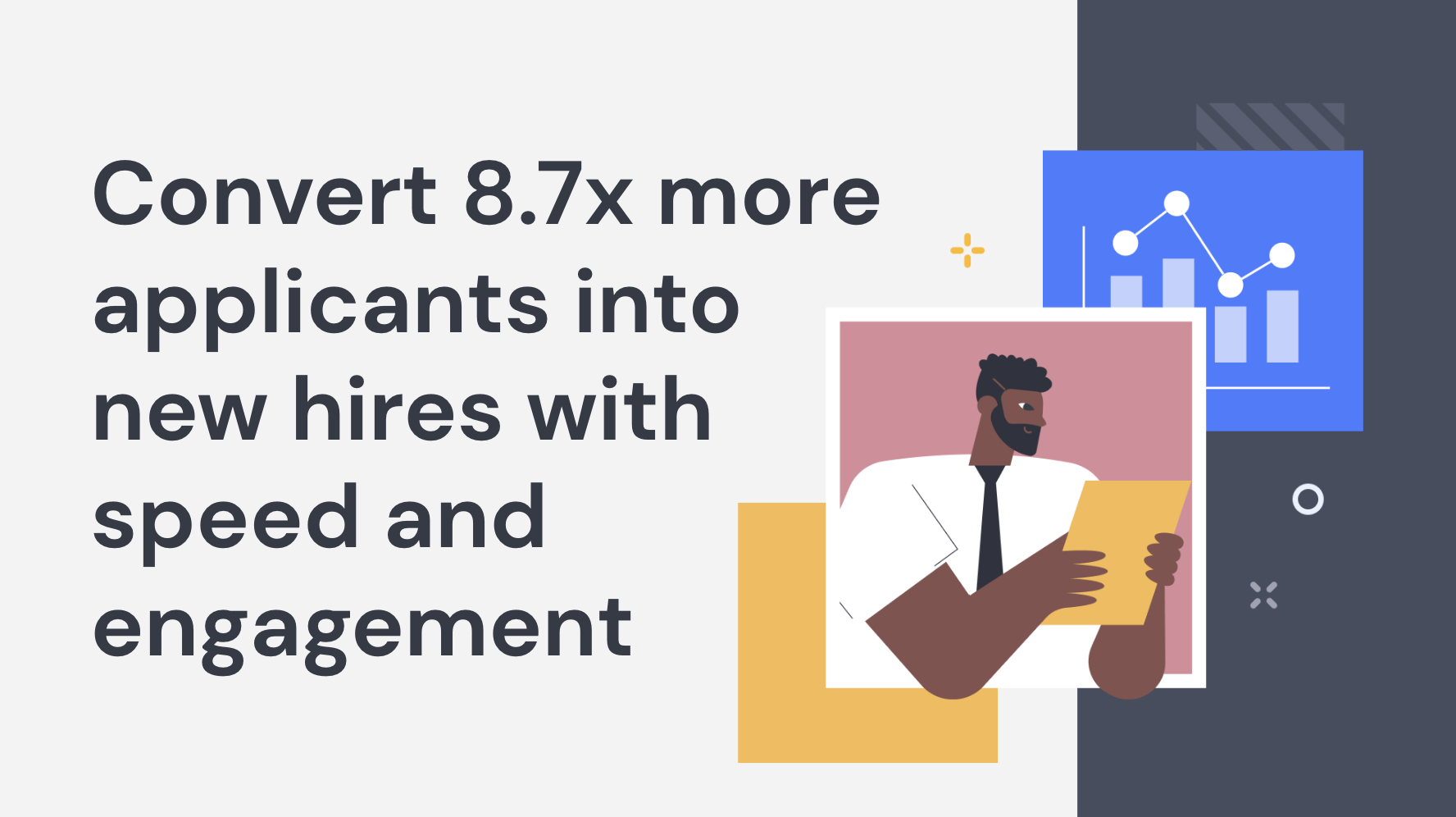The Work Opportunity Tax Credit (WOTC) is a Federal tax credit that aims to encourage employers to hire people who have traditionally faced a lot of difficulties when looking for a job. This includes people who are on unemployment, food stamp recipients, veterans, and ex-felons—to name a few. Employers can claim up to $9,600 in tax credits for each hire who qualifies.
In this webinar, Lydia Hall, Head of Growth at Workstream, answers the question "What is WOTC?" She'll take you on a deep dive into the process of identifying people who qualify as soon as they apply, how to claim the benefits, and how the tax law has changed in 2020.
Read on for the full webinar transcript:
Hello and welcome to Workstream's weekly webinar. This week we are focused on answering the question "What is WOTC?" You'll learn how you as an employer can claim up to $9,600 in credits for every new hire. That sounds like a lot right and one of the best things about this is you can apply it to any year that you owe taxes, this year or any year in the next 20 years. So let's dig in a little bit more about what is WOTC.
So it's a Federal tax credit available to employers for hiring individuals from targeted groups who have consistently faced significant barriers to employment. And you know, when you think about what those groups are, some of it has to do with where they live, what other circumstances they've been dealing with, and areas where there are low employment rates. So we'll dig in a little bit more about this.
If you try to file for WOTC tax credits and you just do the automatic WOTC form filing when you have a new hire, you'll see the average by industry you could be getting. So without any additional work on your end in terms of trying to like find those people, if you're hiring hourly workers in the construction, food and beverage, healthcare, hospitality, manufacturing or retail, this is the average amount that you will get for 100 hires that you make in tax credits just by having them fill out an 8850 form and pushing that information through to the IRS. There's a little bit more that they require on the back end, we'll get to that. Thankfully we also make it so you can just automate that part. So who qualifies for the WOTC?
How to Qualify for the WOTC
There are a few different groups, one of the biggest misconceptions about WOTC is that it's all about hiring ex-cons and this is actually the smallest group of people who people claim benefits for, or rather claim tax credits for.
The number one are hiring people who receive food stamps. They're called SNAP Supplemental Nutrition Assistance Program. Now eight to ten percent of Americans are on these food stamp benefits. You can hire somebody who's not on food stamp benefits but someone else in their family is receiving SNAP and you can get a max tax credit of $2,400 per year just because somebody qualifies under these rules.
Similarly welfare is the other use the second biggest it's a long term TANF Temporary Assistance for Needy Families. So if there's somebody who's receiving welfare either who you hire or they have someone in their family who is on this benefit, you can similarly get the tax credits up to $9000 in tax credits you know for hiring a person who qualifies there.
Designated Community Resident. Now this is the most vague and underutilized area but it covers the biggest population of the United States. So Empowerment Zones, if somebody lives in one of these zones and they're between the ages of 18 and 39, they will qualify you as an employer to be able to claim tax credits and then if they live in a rural area that is somewhere that is far away from a lot of employment opportunities, they similarly will qualify you as an employer to claim tax credits for hiring them and you can see there are a lot of rural counties. Keeps going on and on and on and if you want the full list there is a WOTC guide on workstream.us under ebooks and you can see the full list there we have it updated for 2020. So a Designated Community Resident they really just need to live within those zones and be between the ages of 18 and 39.
Going back the Supplemental Security Income, this is generally for people who are over the age of 65 or if they are blind or they are disabled so if you hire somebody who's over 65, chances are you could be getting another $2400 in tax credits.
Unemployment Benefits. This is one of the best things to take advantage of right now, because we have a ridiculously high unemployment rate in the U.S. with everything going on in the world. If you hire somebody who has been on unemployment benefits for 27 consecutive weeks so six months basically and they've received it, you as an employer by helping them get off of unemployment benefits and giving them a job can receive $2400 in tax credits.
Veterans, if you hire a veteran there are lots of ways this is the biggest tax credit you get $9600 in tax credits, which is you know even more than hiring somebody who is on welfare or has somebody else in their family who is on welfare. Veteran you just need to make sure that they have been out for at least two months, that they fit one of the criteria listed below so they don't need to fit all four of those but it's somebody who is a veteran and either has somebody who received food stamps which again is eight to ten percent of the U.S. population, somebody who has a disability, somebody who has been unemployed for at least one month which again is very common right now or there's an aggregate period of unemployment at least six months during the prior year.
Ex-felon. This is a group which people misconstrue as being what the WOTC is about, an ex-felon qualifies you for $2,400 in tax credits. It has to be within one year that they were released from prison or one year from when they were convicted so it's a very small window and very few people take advantage of this. I would suggest if you do add screening questions to see whether or not people who are applying to your job might qualify you for this tax credit, separate out the ex-felon question and the veteran question from the other like food stamps, welfare resident questions because generally when people see ex-felon they are like 20% less likely to fill out the form to see that they qualify because they think that this is something that's negative versus something that actually helps them get hired.
Vocational Rehab Referral is a person with a mental or physical disability who's receiving services. There are organizations in your state that you can work with to help identify people who you could hire through this program and you'll get the tax credit and then Summer Youth, it's a summer youth. If you're hiring seasonal workers this is something, look into it. Anyway why don't more people file for WOTC?
Why File for WOTC
Honestly it's really underutilized because it sounds bad. I mean it sounds like you have to hire, you have to do prejudicial or some discriminatory hiring practices and it seems very complicated because it used to be very complicated. You also used to have a very short time period only 28 days from date of hire to file the paperwork, right now you actually have until July 15th because of the CARES Act. So you can file WOTC every single time you hire somebody, it's just have them fill out one form 8850 that they fill as part of their onboarding process and then what you claim is you're claiming 40% of their eligible qualified wages up to the limit like up to that $9,000 so what the government wants to make sure is have you actually paid this person in the case of $9,000 like have you paid this person over $20,000 so that when you're getting the $9,000 credit back it's less than what you have actually paid them. They don't want people taking advantage of this but if somebody you know you hire somebody and after just three weeks they quit, you can still claim 25% of what you paid that person for the WOTC tax credits.
How to Apply for WOTC
So the way that you apply if you want to do this manually, so if you want to do this just on your own without Workstream, without WOTC.com like any of that there are five steps. You fill out the form, there's one other form for individual characteristics so it's a pre-screen form and then you're like oh this person looks like they might qualify. You give them this additional form and if it's the $9,000 credit that you want to file for for you know some there's a separate one for that but there's also the long-term unemployment recipient for people to say yes I was unemployed for a period of 27 weeks so they have to fill out a form there. Again you can tell employees like this benefits them because well I'll get to it on the next slide but basically it's like you were giving them an advantage because of these tax credits so you are asking them to fill this out as part of their employment process. Anyway fill out the forms, receive a determination and then you claim your tax credits yeah you can get them file them any time in the next 20 years.
The way that we make this easy is the most complicated part of WOTC filing is that you have to identify who qualifies and you also have to figure out is it somebody in their family who is on these benefits and thus they qualify you as an employer. So what you basically do is have another company do all that background check and work for you.
The other thing that is complicated is you need to submit the payroll proof that you paid this person. So, Workstream integrates with WOTC.com, that way you can just connect whatever payroll system you're doing or you just upload your payroll report and WOTC.com does all this work for you. They've saved companies seven million dollars. That's how many tax credits WOTC.com has pushed for and they're based in New York City.
So okay as an employer it seems like on average you are able to save like $55,000 if you're in food and beverage and you hire 100 people. How could you increase that by 10x? Like how can you get to the point where every single person you employ you know it at least qualifies you for $2,400 because they were on unemployment.
You are allowed to use screener questions before you even choose who to interview to see if the applicant is likely to qualify you for WOTC credits. This sounds discriminatory, it is not. In fact the way that the laws written is if an employer has a choice between hiring two identical applicants, one of whom is eligible for WOTC and one of whom is not, the employer might opt to hire the WOTC eligible applicant. When you get applicants in and you're reviewing their resumes or their application, that is when you can screen and say I want to move these people all to the next stage because they are likely qualified for WOTC, the entire purpose of the WOTC program was to incentivize you to do that so you are not being discriminatory you are doing what WOTC is meant to do, which is help these people who have a hard time getting hired find employment and that way instead of the government paying them benefits, you as an employer are incentivized for you to pay them and so that they are able to work and that's why TANF and other program that are structured as like welfare-to-work is how they're framed.
Workstream and WOTC.com Integration
How to screen for screen with Workstream and WOTC.com? So what we do is we actually identify people who are likely eligible and then we ask them to complete additional WOTC forms, you as a hiring manager can just see like okay this person's getting a text message linked to their phone and they're getting an email and it says "Hey please complete this form as part of your onboarding process." If they don't complete the form they get a little reminder "Hey we haven't seen you fill out this form, could you please make sure to fill it out before your first day or on your first day." and so we take care of all of this sort of like sending the forms out, making sure they're filled out and getting them filed with the IRS within the 28-day window.
You can use screener questions to identify the people. One thing that we're seeing people do a lot of is they're actually building a hiring pool of people who they want to hire for in the future, so a lot of companies right now they're posting on free job boards, Workstream allows you to post on 10 free job boards and I have positions that are live that applicants are coming into and the applicants are asked questions such as you know "Hey could you send over a 30-second intro video of yourself and why you're interested in this position?" and the other question that gets asked all the time is you know "Hey are you or anyone else in your family currently receiving welfare food stamps?" you know make sure you call them by their name SNAP benefits. Unemployment benefits. That's a question and then the next one is "Are you between the ages of 18 and 40?" or "Are you over the age of 65?" those types of questions the way that they're framed if you use the exact language from form 8850, you can do that in a way that's non-discriminatory but make sure to stay within those limits, when it comes to the over 65 part just ask if they are on the SSI benefits, you don't need to ask that they are over the age of 65 for instance so while the other ones say you know like we're seeing whether or not you qualify for WOTC, do you fit these characteristics and this is a voluntary optional thing.
The other think you can have people do is you know like complete questions collect this information and then have it as a pool of applicants you can choose from later on when you are hiring so you can choose okay I want to invite these 30 people who have applied in the past few months to come in and schedule a zoom interview with me and they'll get a text message inviting them and saying like "Hey I wanted to follow up on your application, just wanted to know if you are still interested. Here's a link to my calendar to find time for zoom interview if you're still interested and here is an updated job description." So then in Workstream what you can do is you can see okay here are all of the people who were contacted you know from applying to the job, here's everyone who filled in the form who you know is you can see like the form included the video interview and additional information there then you can see who of those people did you push through to request a phone call, an in-person interview, maybe there's a second one, you offer the job accepted, onboarded, you can do all that in Workstream.
We also just right now because of what's going on the world really want to make sure people know about the video and virtual training and onboarding, so in addition to SMS text you can also send over video training, mobile quizzes, you can do all of the paperwork just e-signature so there's less passing between people unless you know unnecessary interaction and when you are training people you can do the embedded SlideShare with quizzes so lots of other things you can do there. We had so now that's pretty much the end of the webinar.
We had some pre-submitted questions that I'm going to go through right now but yeah I am happy to take any questions you have, you can submit them through the little Q&A part. Cool. So I am going to stop sharing my screen so that I can see the questions. Okay great.
Q&A: coronavirus Aid Relief and Economic Security CARES Act
So one of the pre-submitted questions we had is what about the coronavirus aid relief and Economic Security CARES Act. So if you claim WOTC tax credits on an employee, you can also still get the credits that you could claim through the CARES Act as long as it isn't in the same time period. So if you claim tax credits the WOTC you apply it sometime in the next 20 years that's fine just don't claim it in the same tax period and then as part of the CARES Act you also have an extension on when you need to file WOTC paperwork usually it's 20 days instead it's July 15th just like all of our taxes are due.
Well now guys please feel free to post in the Q&A section or in the chat you can also just post directly to me as a panelist in the chat. Okay cool so another question I have is let me see.
Q&A: Employees Participation
Question is do employees need to participate? So participation is completely voluntary, you can let them know when you're asking these questions that it increases their chances of employment because and use the standard sentence from WOTC. This is something we have built into Workstream so it's like there's a standard template of responses to make sure that you're following the law by the book.
Q&A: Popular Tax Credits
Yeah another question just came through anonymous yeah okay so what are the most popular ones? The most popular tax credits I touched on this briefly before but they're the SNAP recipients so people who are on food stamps. They make up typically 70% of the people who ended up being qualified for WOTC credits. The next highest is Veterans and what's interesting is that the veterans group is the smallest group of people who in the United States should be qualified but 7% of the WOTC credits filed are for veterans. So this just goes to the misconception again that WOTC is really available for hiring like veterans and ex-felons which is not the case.
Q&A: Availability of WOTC Credits
Okay we had a question. WOTC credits are only available upon hire though no ongoing credits if you continue to employ the person in subsequent years. Okay so the way WOTC credits work is when you hire them you have to file immediately. The reason for that is they don't want you doing like oh I realized later and this had no impact on my hiring. They want the WOTC credits to like impact your hiring decisions but you have ongoing credits in the sense that you choose which year to apply the tax credits from that specific person. So if you get $2,400 in tax credits because you hired somebody who is on unemployment, you will be able to choose. I'm going to apply this in five years from now when I have taxes to pay so in that sense it's ongoing. The Long Term Temporary Assistance I know it's an oxymoron but the Long Term Temporary Assistance something N F like TANF the welfare program Those are applied over two years so instead of just getting that for hiring somebody for the first year, you get half the credits the first year and half the second but with the rest it's like you basically get them as soon as you have paid the person at least what is it like 2.5x what you're claiming because only 40% of their eligible wages are able to be claimed by you. So if you're claiming $2,400 and tax credits you are able to claim that once you've paid the person like six or seven thousand dollars because 40% of that is the $2,400 that you're claiming. I'm making this more complicated than it is. It's a little bit complicated which is why Workstream has the integration with WOTC.com and the tax professionals take care of all this to maximize your credits.
Q&A: SNAP Qualification Time Frame
Is there a minimum time someone has to be on SNAP to qualify? Sure so let me go back to that side. Okay So the to answer your question, the minimum someone needs to be on food stamps to qualify is for a period of six months up until you know the day that they joined your employment or they've received it for three months so sorry it's three months is the minimum if the person who you're hiring is the one who is receiving food stamps but if it was a family member such as their children which is usually the case, that child had to have received food stamps for a six-month period up until they were employed. So the minimum is three months within the last five month period. If it's the employee six months, if it's the family member but yeah let me know if you have any additional questions about that and again through Workstream in WOTC.com we take care of all of this so it's just by the book of okay this person filled out a form and they follow up with them and get the additional information and they make recommendations about how you can find more of these people so you can claim more tax credits.
Cool. Well unless there are any other questions I think that wraps up today. I want to thank everyone who tuned in, you can contact me lydia@workstream.is if you have any additional questions and there's also a WOTC guide if you go to Workstream.us and you go to resources, ebooks. There's a very long very thorough guide that covers all the has all of the locations that you could be claiming somebody for the Designated Community Residents so it's also really helpful to see which counties nearby and which urban areas within for instance within Baltimore within New York City within LA you know to understand how where people need to live to be able to claim a $2400 there.
So anyway thank you guys again for tuning in and then we have another webinar next Wednesday at 11 a.m. so please check it out and look forward to seeing you then. Thanks.





